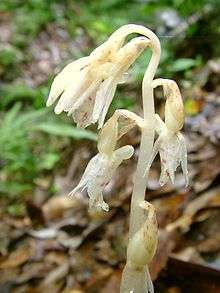Epipogium roseum
Epipogium roseum, commonly known as the ghost orchid, leafless nodding orchid[2] or 虎舌兰 (hu she lan),[3] is a leafless terrestrial mycotrophic orchid in the family Orchidaceae. It has up to sixteen cream-coloured, yellowish or pinkish flowers with an enlarged ovary on a fleshy hollow flowering stem. This ghost orchid is widely distributed in tropical Africa, Asia, Southeast Asia, New Guinea, Australia and some Pacific Islands.
| Ghost orchid | |
|---|---|
 | |
| Epipogium roseum growing near Hiratsuka-city, Japan | |
| Scientific classification | |
| Kingdom: | |
| (unranked): | |
| (unranked): | |
| Order: | |
| Family: | |
| Subfamily: | |
| Tribe: | Epipogieae |
| Subtribe: | |
| Genus: | |
| Species: | E. roseum |
| Binomial name | |
| Epipogium roseum | |
| Synonyms[1] | |
| |
Description
Epipogium roseum is a leafless, terrestrial mycotrophic herb that has a fleshy underground rhizome and a fleshy, hollow, dull yellow flowering stem 200–600 mm (8–20 in) tall. There are between two and sixteen resupinate cream-coloured, yellowish or pinkish flowers 10–12 mm (0.4–0.5 in) long with an unusually swollen overy. The sepals are linear to lance-shaped, 8–11 mm (0.3–0.4 in) long, 2–3 mm (0.08–0.1 in) wide and the petals are often slightly shorter and wider. The dorsal sepal and petals are joined at the base and spread weakly. The labellum is egg-shaped, 11–14 mm (0.4–0.6 in) long, 4–5 mm (0.16–0.20 in) wide with a spur at its base. Flowering occurs from December to March in Australia and from April to September in China. The plants appear a few days after the first heavy rains of the wet season and set seed within a few days.[2][3][4][5][6]
Taxonomy and naming
This ghost orchid was first described in 1857 by David Don who gave it the name Limodorum roseum and published the description in Prodromus florae Nepalensis.[7][8] In 1857, John Lindley changed the name to Epipogium roseum.[1] The specific epithet (roseum) is a Latin word meaning "rose-coloured".[9]
Distribution and habitat
Epipogium roseum grows in high rainfall habitats, especially rainforest, on decaying wood. It is found in many countries including China, India, Indonesia, Japan, Kashmir, Laos, Malaysia, Nepal, the Philippines, Sri Lanka, Thailand, Vietnam, tropical Africa, New Guinea, Australia and some Pacific islands including the Solomon Islands. In Australia it occurs from the Windsor Tableland in Queensland to the Macleay River in New South Wales.[2][3][10]
References
- "Epipogium roseum". World Checklist of Selected Plant Families (WCSP). Royal Botanic Gardens, Kew.
- Jones, David L. (2006). A complete guide to native orchids of Australia including the island territories. Frenchs Forest, N.S.W.: New Holland. p. 360. ISBN 1877069124.
- "Epipogium roseum". Flora of China. Retrieved 7 November 2018.
- "Epipogium roseum". Orchids of New Guinea. Retrieved 8 November 2018.
- "Epipogium roseum". Trin keys: Australian Tropical Rainforest Orchids. Retrieved 8 November 2018.
- Weston, Peter H. "Epipogium roseum". Royal Botanic Garden Sydney. Retrieved 8 November 2018.
- "Limodorum roseum". Retrieved 8 November 2018.
- Don, David (1857). Prodromus florae Nepalensis. London. pp. 30–31. Retrieved 8 November 2018.
- Brown, Roland Wilbur (1956). The Composition of Scientific Words. Washington, D.C.: Smithsonian Institution Press. p. 651.
- Hsu, Tian-Chuan; Yang, T.-Y. Aleck; Pitisopa, Fred; Fanerii, Moffat; Li, Chia-Wei (2016). "New records and name changes for the orchids in the Solomon Islands" (PDF). Taiwania. 61 (1): 24. Retrieved 8 November 2018.